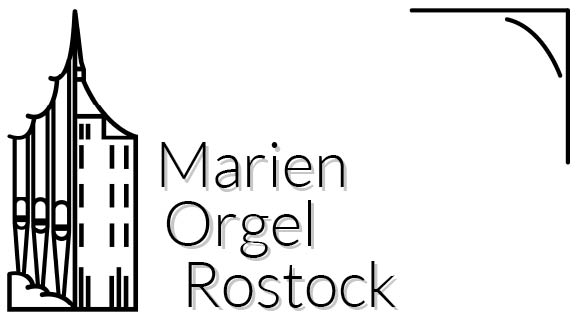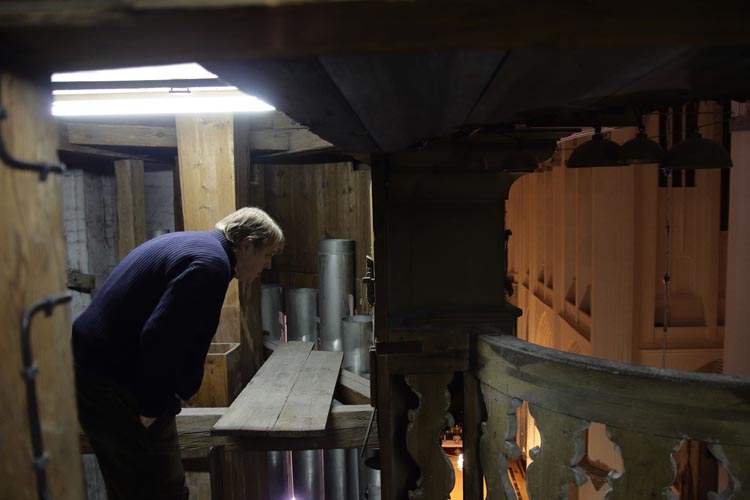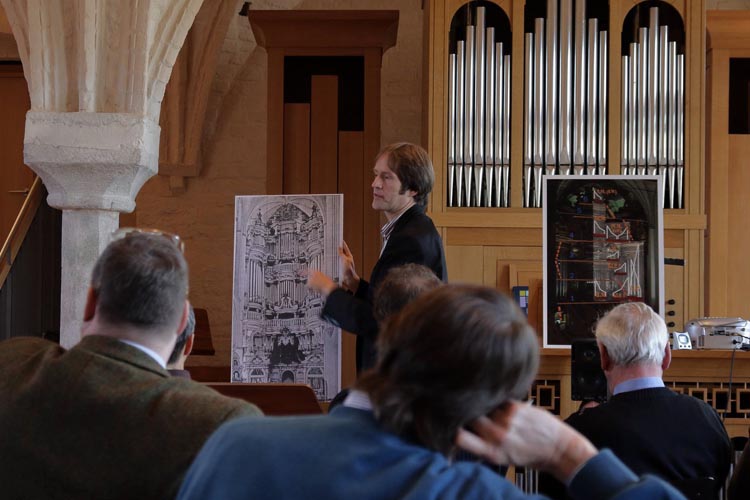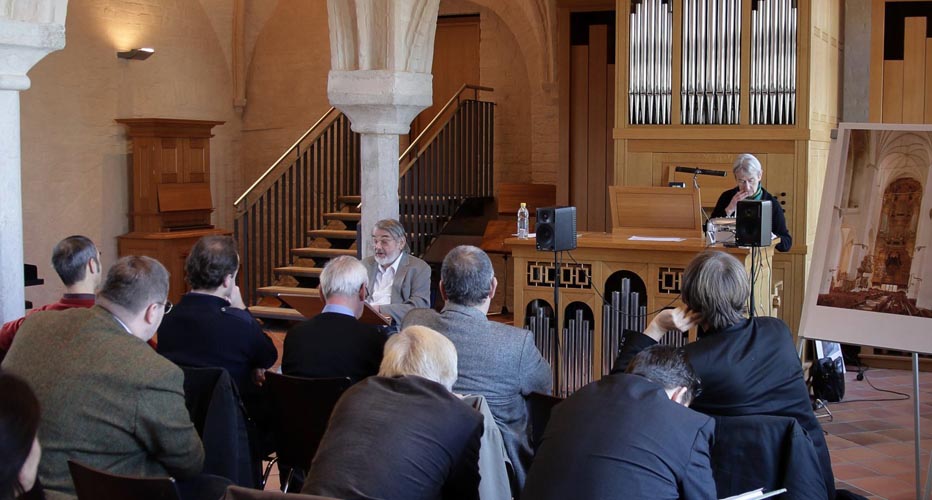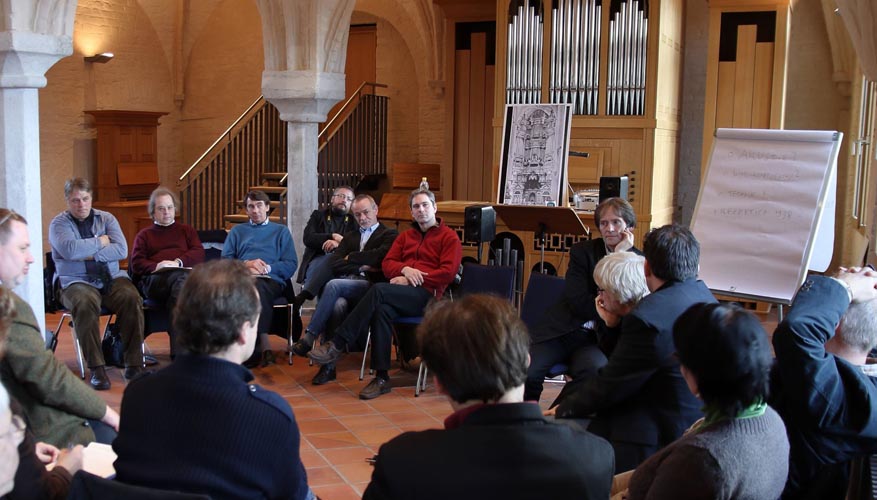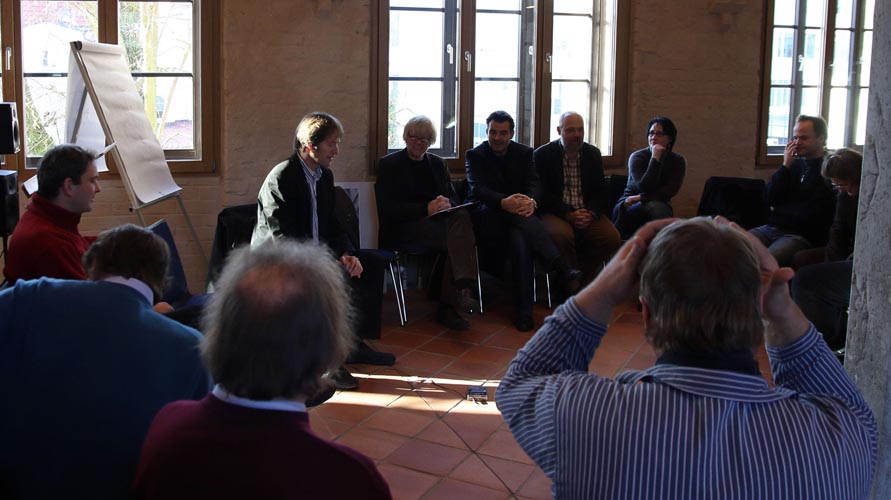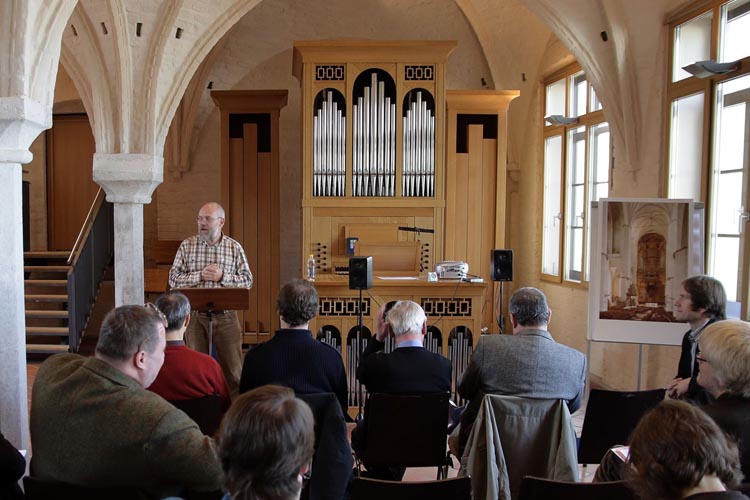10 Years ago: Symposium regarding the future of St. Mary’s organ
In November 2009, the organist of St. Mary’s, on behalf of the Lutheran City Parish, invited to a Symposium regarding the future of the organ of St. Mary’s church of Rostock. Kropf entered service in 2007. His predecessor, KMD Joachim Vetter, has already in 200 called for suggestions and concepts from some organ builders, to proceed plans for a restoration (resp. for a new build, as most of the expertises suggested a new instrument). But this was hindered by the more urgent demands of solving problems of the building itself.
When the measures of restoring and saving the church neared completion (currently, they are finished exept two windows of the northern aisle), there was more space to deal with “luxury problems” like the organ.
Preparation
Some months in advance, Dr. Martin Kares (Karlsruhe) has spent a day to investigate the organ and wrote an expertise, which though relied also on meanings of the organist and on already published (but not checked) sources.
Tonal presentation and visting of the organ
On Friday 6 Nov the organ was presented tonally by the organist. Retrospective, it can be said that this presentation suffered by the low temperature (7° Celsius) and the fact, that K.-B. Kropf decided to focus on the numerous colours and smaller combinations of stops, saving full organ sounds for a short section at the end. Thus the prejudices of a weak sound have been strengthened (One participant created the title “Largest Aethereal Division of the World”…). The audience was somewhat surprised about the fact, that there was still the possibility to create at least some tonal power.
Following the presentation, the organ was visited extensively, giving the participants an impression of the complex and problematic technical situation of the instrument.
Lecture, statements and discussion
For Saturday 7 Nov, Rostock Academy of Music and Dramatic Arts made the organ hall available for the discussions. Thanks go to the administration for this.
The day started with a Lecture by Prof Dr Hermann J. Busch (University of Siegen, Germany) entitled “Organ music in 1938 – a european panorama”, illustrated with music samples.
Afterwards, some of the organ builders or organ experts have been listed for contributions.
Originally, it was intended to give short summaries of those statements here. But during preparation it became obvious, that the until now unfinished transscription of the statements and the discussion will have to be completed and published. This will take some extra time.
Update 2021: The report has been published! Read more>
After lunch, a discussion round was opened. Participants confirmed their scepticism regarding the worth of everything built in 1938, though it was acknowledged, that the pipe material has some qualities.
There was consense in asking for much better research of the sources in the archives and that some experiments should be undertaken. Focus was on the 2nd manual, inofficially called “Hauptwerk”. This division should be equipped with better wind supply and the pipework subsequently reworked resp. revoiced. This measure should allow judging its potential for the whole instrument.
There was a more radical suggestion by OBM Kristian Wegscheider, who found it better to remove all extent pipework from this windchest and to replace it by new pipes (let it be few stops only), built to baroque models. Even better it were if a temporary tracker console would be attached to this windchest, as the way for the action would be very short and relatively easy to set up.
In general, the historic windchests should be measured for their sustainability within a future utilisation (no matter if used in a more contemporary or a baroque-recinstructive context).
The round expressed the hope that one of these measures could see realization, and that the group will be able to meet again to discuss the outcome.
From the report of Wolfgang Baumgratz in Ars organi 58/1 (march 2010, p. 52-53):
The summary of this symposium was: A possible restoration of this meaningful organ can only be achieved by a complicated, long-term and also controversial process. The desired result will be to put this special organ into a tonally and technically prominent condition, granting and maintaining it a place within the rank of the meaningful instruments by Buchholz, Friese and Walcker in the north-east-german organ world.
What has been implemented? How did the situation develop?
- It became obvious, that the parish would not be able to fund extensive experiments. In the following years, many visiting organists and K.-B. Kropf himself let the organ sound much better than it should officially be able to, also due to the fact that some minor faults could be overcome.
- Around the 2nd manual and ove some cavities of the casework, reflection shields (heavy plywood) were installed. This measure was funded by the former Mecklenburg Lutheran Church, its effect was rather poor, as predicted by some of the symposium participants.
- In 2019, Martin Dücker (member of the advisory board) researched historic sources within Rostock archives, focusing on the era of Schmidt and Marx. It became obvious, that already the contemporary approval reports named major faults of the organ.
- Also in 2019, the windchests have been investigated and extern pipes were placed into the organ. The investigation resulted in the opinion, that it would not be impossible to re-use the historic windchests. Regarding the pipes, the prediction of symposium members was confirmed that there is a need for more powerful pipework, that would be able to overcome the acoustical difficulties of the facade.
- Recent trends of european organ building show some remarkable developments, having a more relaxed dealing with electric controls resp. action and the aim to discover new possibilities ofa heavily controlable pipe sound (“wind dynamic organs”). Those aspects were taken into account by the advisory boards starting at the first meeting in 2019.
- A strong increase in touristic visitor numbers for Rostock and experience with visitors showed the people in charge, that there is a high interest in organ culture, and that any measures to popularize it are necessary and fruitful.
All future developments will be reported on this website.
More details also to be found in the report published in 2021>
Symposium Participants
There was no official participants list, therefore this is only a reconstruction and persons may be missing.
OBM Chistian Scheffler, Sieversdorf
OBM Kristian Wegscheider, Dresden
OB Philipp C. Klais, Bonn
OBM Matthias Schuke with OB Klaus-Michael Schreiber, Werder,
OSV/OB Friedrich Drese (organ advisor of the former Mecklenburg Lutheran Church, today Luthern Church of the North)
OBM John Pike Mander, London
OBM Johann-Gottfried Schmidt, Rostock
OSV/OB Dr. Martin Kares, Karlsruhe
Prof. KMD Wolfgang Baumgratz, Cathedral Organist Bremen (reporting for the GdO/”Ars organi”)
Prof. Dr. Hermann J. Busch (Siegen University) with Sibylle Schwantag
Beatrix Dräger-Kneißl, Heritage Authority of Mecklenburg Vorpommern State
Frank Sakowski, Director of Works at St. Marien church for Angelis & Partner, Wismar
Tilman Jeremias, Pastor of St. Marien
Uta Jahnke, Heritage Authority of the Hanseatic City of Rostock
Wolfgang Leppin, former organ advisor, Güstrow
OSV Oliver Horlitz, Berlin
Regina Klee, restorer
Alexander Eckert, organ builder / restorer
Hans-Dieter Karras, organist
Wolfgang Gourgé, organ expert
and more
Organisation and presentation: Karl-Bernhardin Kropf, Kirchenmusiker an St. Marien Rostock
Images provided by Wolfgang Gourgé
